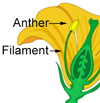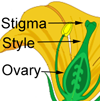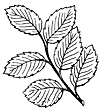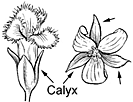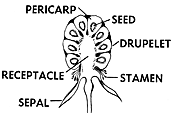Brazilian Pepper-tree
Schinus terebinthifolia
Sumac family (Anacardiaceae)
Post-Cook introduction
This attractive introduced ornamental shrub or small tree has become widely naturalized and is a weed. It has leaves with narrowly winged axis and five, seven, or nine shiny clusters of small white flowers, and many bright red poisonous 3⁄16 inch (5 ) in diameter. The aromatic resinous sap produces a rash or dermatitis in some persons.
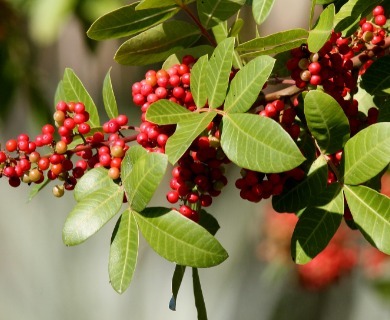
©2006 Anthony Valois and the National Park Service
Leaves 3–6 inches (7.5–15 ) long, with narrowly winged green finely hairy axis of 1–3 inches (2.5–7.5 ) and mostly 5, 7, or 9 (3–13 or more in varieties) stalkless paired except at end. elliptical or oblong, 1–2 inches (2.5–5 ) long and 1⁄2–3⁄4 inch (1.3–2 ) wide, the largest at end to 3 inches (7.5 ) by 1 inch (2.5 ), short-pointed at both ends, often with inconspicuous small blunt teeth toward slightly thickened, hairless or nearly so, upper surface shiny green with several straight side veins, and lower surface dull light green.
Flower clusters () mostly at the base of upper leaves, 1–4 inches (2.5–10 ) long, much branched, composed of many short-stalked flowers, partly male and female on different plants (). Flower about 1⁄8 inch (3 ) long and broad consists of of five tiny pointed green of five spreading white petals less than 1⁄8 inch (3 ) long; 10 attached at base of large ring-shaped and with rounded short and dot
() are many in dense clusters, bright red, with at base and dot at with aromatic resinous brown pulp, slightly bitter. Seed single, elliptical, light brown, less than 1⁄8 inch (3 ) long. Female plants produce abundant which mature mostly in autumn and remain attached until December.
The hard, heavy, reddish brown wood is utilized in Hawaii only as firewood and chipped mulch from trees cut during land clearing.
Fruiting branches are picked for making Christmas wreaths and decorations. Classed as a honey plant.
Christmas- was introduced into Hawaii before 1911 as an ornamental. Later, it was planted extensively through the islands for the bright red berries and shiny foliage used in Christmas decorations. It has escaped widely in dry lowlands and now is classed as an undesirable weed. It is very common in Ka‘u and North Kona on Hawaii, southeastern Maui, and on Oahu near Mokuleia.
Special areas
Waimea Arboretum, Foster, Tantalus, Haleakala, City, Volcanoes
Champion
Height 39 ft (11.9 ), c.b.h. 12.5 ft (3.8 ), spread 46 ft (14.0 ). Waimea Village, S. Kohala, Hawaii (1968).
Range
Native of southern Brazil, Paraguay, and Argentina. Introduced northward to the southern border of continental United States and in Old World tropics.
Spreading rapidly as a weed in southern Florida and known there as “Florida-holly.” Planted also as an ornamental in southern California, southern Arizona, Puerto Rico, and Virgin Islands.
Other common names
Christmas- tree, wilelaiki, nani-o-Hilo (Hawaii); Brazil peppertree (continental United States); pimienta de Brazil (Puerto Rico)
The Hawaiian name wilelaiki, according to Neal, refers to Willie Rice, a politician, who often wore a hat lei of the berries.
Some people are sensitive to the resinous sap, which produces a rash or dermatitis. Pollen may cause sneezing and headaches, and the are poisonous.
